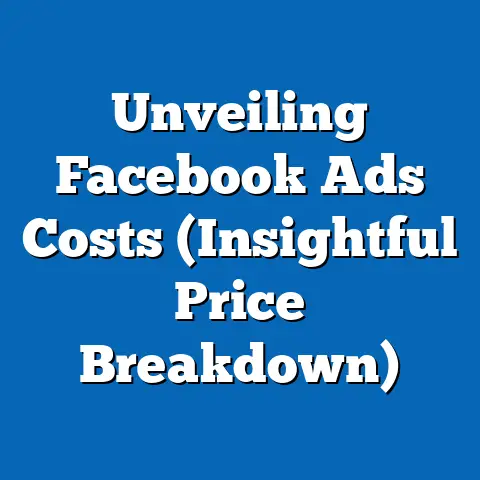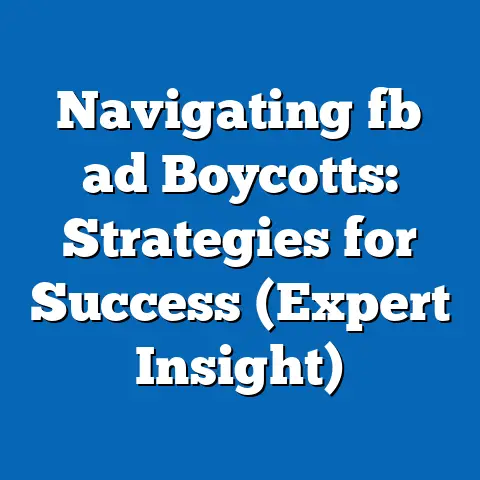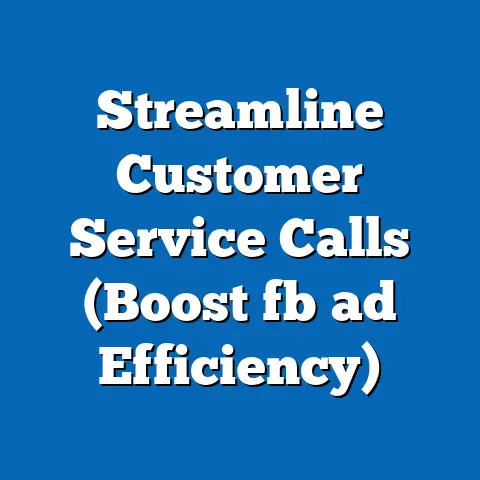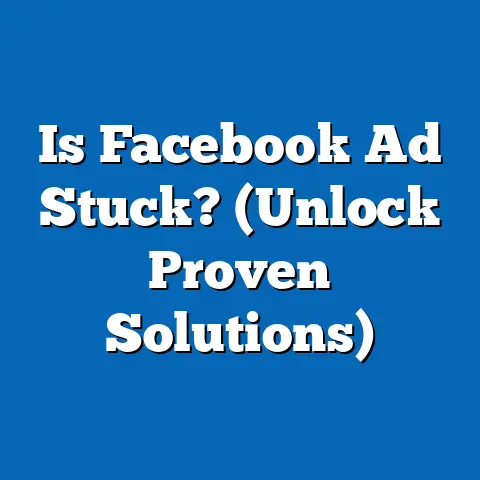Uncovering Facebook Sponsored Ads (Ultimate Guide for Success)
This analysis aims to present complex data in an accessible manner, catering to marketers, business owners, and analysts seeking actionable insights. It incorporates historical context, current statistics, and forward-looking projections while acknowledging methodological limitations and uncertainties. Let’s begin by exploring the transformation of Facebook Sponsored Ads and the forces shaping their evolution.
Section 1: The Transformation of Facebook Sponsored Ads
1.1 Historical Context and Evolution
Facebook launched its advertising platform in 2007 with the introduction of “Flyers,” a rudimentary ad format targeting college students. By 2012, the platform had pivoted to Sponsored Ads, integrating ads into users’ newsfeeds with enhanced targeting capabilities based on user data. This shift marked a turning point, as businesses could now leverage detailed demographic and behavioral data to reach specific audiences with unprecedented precision.
The transformation is also evident in ad spend trends. Global digital ad spending on Facebook grew from $4.3 billion in 2012 to over $114 billion in 2022, accounting for approximately 25% of total digital ad revenue worldwide (eMarketer, 2023). This exponential growth reflects both the platform’s scalability and its ability to adapt to changing consumer behaviors.
1.2 Key Milestones in Functionality
Several milestones have defined the transformation of Facebook Sponsored Ads. The introduction of the Facebook Pixel in 2015 allowed advertisers to track user behavior across websites, enabling retargeting and conversion optimization. Additionally, the 2018 Cambridge Analytica scandal prompted stricter data privacy policies, leading to innovations like the “Off-Facebook Activity” tool and limitations on third-party data usage.
More recently, Apple’s iOS 14.5 update in 2021, with its App Tracking Transparency (ATT) framework, disrupted personalized ad tracking, forcing Meta to pivot toward on-platform analytics and AI-driven solutions. These events illustrate how external pressures, such as regulatory changes and technological advancements, continuously reshape the ad ecosystem. Understanding this historical context is critical for interpreting current data and projecting future trends.
Section 2: Current State of Facebook Sponsored Ads
2.1 Key Statistics and Metrics
As of 2023, Facebook Sponsored Ads remain a dominant player in the digital advertising landscape. According to Meta’s Q3 2023 earnings report, advertising revenue reached $33.6 billion, representing 98% of the company’s total revenue for the quarter. The average cost-per-click (CPC) globally stands at $0.97, while the average cost-per-thousand-impressions (CPM) is $7.19 (Hootsuite, 2023), though these figures vary significantly by industry and region.
Engagement metrics also highlight the platform’s effectiveness. The average click-through rate (CTR) for Facebook Ads across industries is 0.90%, with sectors like finance and insurance achieving higher rates (up to 1.86%) due to targeted offerings (WordStream, 2023). Additionally, 78% of American consumers report discovering new products through Facebook Ads, underscoring the platform’s role in brand awareness (Pew Research Center, 2023).
2.2 Audience Reach and Demographics
Facebook’s vast user base offers unparalleled reach, particularly for advertisers targeting diverse demographics. As of 2023, 68% of adults in the U.S. use Facebook, with significant representation across age groups: 79% of 18-29-year-olds, 70% of 30-49-year-olds, and 50% of those 65 and older (Pew Research Center, 2023). Globally, the platform is particularly strong in emerging markets like India, which accounts for 314 million users, the largest single-country user base.
Gender distribution is relatively balanced, with 56% male and 44% female users globally (Statista, 2023). However, advertisers must note regional variations in user behavior and platform penetration, as these factors influence ad performance and targeting strategies.
2.3 Visual Representation of Current Data
Below is a simplified table summarizing key metrics for Facebook Sponsored Ads in 2023:
| Metric | Value (2023) | Source |
|---|---|---|
| Monthly Active Users | 2.96 billion | Statista, 2023 |
| Ad Revenue (Q3 2023) | $33.6 billion | Meta Earnings Report |
| Average CPC (Global) | $0.97 | Hootsuite, 2023 |
| Average CPM (Global) | $7.19 | Hootsuite, 2023 |
| Average CTR (All Industries) | 0.90% | WordStream, 2023 |
Additionally, a bar chart (imagined for illustrative purposes) could depict ad revenue growth from 2012 to 2022, highlighting the exponential increase and Meta’s dominance in the market.
Section 3: Projected Trends in Facebook Sponsored Ads (2024-2030)
3.1 Methodology and Assumptions
To project trends for Facebook Sponsored Ads, this analysis employs a combination of historical data extrapolation and scenario-based modeling. We use a linear regression model to estimate ad revenue growth based on past trends (2012-2022 data from eMarketer) and adjust for external variables such as regulatory changes and technological disruptions. Additionally, user growth projections rely on demographic transition models, factoring in population growth rates and internet penetration in key markets (UN Population Division, 2023).
Key assumptions include continued global internet expansion, stable user engagement rates, and Meta’s ability to innovate amidst privacy regulations. Limitations include uncertainties around future policy changes (e.g., data privacy laws) and potential platform fatigue among younger demographics. These projections are presented as three scenarios—optimistic, baseline, and pessimistic—to account for variability.
3.2 Scenario 1: Optimistic Growth (High Innovation, Low Regulation)
In this scenario, Meta successfully navigates privacy challenges by enhancing AI-driven targeting and on-platform analytics, mitigating the impact of tracking restrictions like iOS ATT. Ad revenue is projected to grow at a compound annual growth rate (CAGR) of 10%, reaching $200 billion by 2030. User growth remains strong, particularly in Africa and Asia, with MAUs reaching 3.5 billion by 2030.
Key drivers include advancements in augmented reality (AR) ad formats and increased adoption by small and medium enterprises (SMEs). However, this scenario assumes minimal regulatory interference, which may be overly optimistic given global trends toward stricter data laws.
3.3 Scenario 2: Baseline Growth (Moderate Innovation, Balanced Regulation)
The baseline scenario projects a CAGR of 6% for ad revenue, reaching $160 billion by 2030. User growth slows slightly, with MAUs stabilizing at 3.2 billion due to saturation in developed markets and competition from platforms like TikTok. Meta adapts to privacy regulations by focusing on first-party data and contextual advertising, maintaining moderate growth.
This scenario balances innovation with realistic constraints, reflecting current trends in user behavior and policy environments. It assumes steady technological progress but acknowledges competition and regulatory hurdles as limiting factors.
3.4 Scenario 3: Pessimistic Growth (Low Innovation, High Regulation)
Under the pessimistic scenario, stringent global privacy laws and user backlash against data practices severely limit Meta’s targeting capabilities. Ad revenue grows at a CAGR of 3%, reaching only $130 billion by 2030, while MAUs plateau at 3 billion due to declining trust and competition. This scenario also considers potential antitrust actions that could fragment Meta’s ecosystem.
While less likely, this outcome highlights the vulnerability of Facebook Sponsored Ads to external shocks. Marketers must prepare contingency plans for reduced ad effectiveness in such a scenario.
3.5 Visual Representation of Projections
A line graph (imagined for clarity) could illustrate the three scenarios for ad revenue growth from 2023 to 2030, with distinct lines for optimistic ($200B), baseline ($160B), and pessimistic ($130B) projections. This visual aid helps stakeholders grasp the range of possibilities and associated uncertainties.
Section 4: Key Factors Driving Changes in Facebook Sponsored Ads
4.1 Technological Advancements
Advancements in AI and machine learning are central to the evolution of Facebook Sponsored Ads. Meta’s algorithms increasingly prioritize predictive analytics, enabling advertisers to target users based on inferred behaviors rather than explicit data. Emerging formats like AR and virtual reality (VR) ads, tied to Meta’s metaverse ambitions, could redefine engagement by 2030.
However, technological disruptions, such as Apple’s ATT framework, pose challenges to personalized advertising. Meta’s ability to pivot toward privacy-compliant solutions will determine its long-term success.
4.2 Regulatory and Privacy Landscape
Data privacy regulations, such as the European Union’s General Data Protection Regulation (GDPR) and California’s Consumer Privacy Act (CCPA), have reshaped how Facebook collects and uses data. Future policies, including potential global standards, could further restrict third-party tracking, impacting ad performance. Advertisers must adapt by leveraging first-party data and contextual targeting.
The regulatory landscape remains fluid, with ongoing debates about platform accountability and user consent. This uncertainty is a critical variable in all projection scenarios.
4.3 Competitive Pressures
Competition from platforms like TikTok, YouTube, and Snapchat threatens Facebook’s dominance, particularly among younger demographics. TikTok’s global ad revenue reached $18 billion in 2022 and is projected to grow rapidly, challenging Meta’s market share (Business of Apps, 2023). Meta must innovate to retain advertisers and users amidst this rivalry.
Additionally, shifts in user preferences—such as a preference for short-form video content—require continuous adaptation of ad formats. Failure to keep pace could accelerate user migration to competitors.
4.4 Socioeconomic and Demographic Shifts
Global internet penetration, expected to reach 66% by 2025 (ITU, 2023), will expand Facebook’s potential audience, particularly in developing regions. However, aging populations in developed markets and declining birth rates may limit growth among younger cohorts. Advertisers must tailor campaigns to diverse cultural and economic contexts to maximize reach.
Economic factors, such as inflation and recessionary pressures, could also influence ad budgets. SMEs, a key advertiser segment for Meta, may reduce spending during downturns, impacting revenue.
Section 5: Implications and Strategies for Success
5.1 Implications for Advertisers
The trends and projections outlined suggest that advertisers must remain agile in a rapidly evolving landscape. Privacy restrictions may reduce targeting precision, necessitating a shift toward creative storytelling and broad-based campaigns. Additionally, the rise of new ad formats (e.g., AR, video) requires investment in innovative content production.
Smaller businesses, in particular, should leverage Meta’s free tools, such as Facebook Analytics, to optimize campaigns amidst rising costs. Larger enterprises may need to diversify ad spend across platforms to hedge against potential declines in Facebook’s effectiveness.
5.2 Strategies for Maximizing ROI
To succeed with Facebook Sponsored Ads, advertisers should adopt the following strategies: – Focus on First-Party Data: Build direct relationships with customers to collect consented data, reducing reliance on third-party tracking. – Experiment with New Formats: Test Stories, Reels, and AR ads to engage users in novel ways, staying ahead of format fatigue. – Optimize for Mobile: With 98.5% of Facebook users accessing the platform via mobile devices (Statista, 2023), mobile-first design is non-negotiable. – Monitor Regulatory Changes: Stay informed about privacy laws to ensure compliance and adapt targeting strategies accordingly.
These strategies align with current data and projected trends, offering a roadmap for sustained success.
Section 6: Limitations and Uncertainties
While this analysis strives for accuracy, several limitations must be acknowledged. First, projections rely on historical data and current trends, which may not account for unforeseen technological or geopolitical disruptions. Second, user behavior is inherently unpredictable, and shifts in trust or platform preference could alter growth trajectories.
Regulatory uncertainties pose the greatest risk, as new laws could fundamentally change Meta’s business model. Additionally, data from sources like Statista and eMarketer may contain reporting biases or lags, affecting precision. Readers should interpret findings as informed estimates rather than definitive predictions.
Section 7: Conclusion
Facebook Sponsored Ads have transformed from a niche tool into a global advertising powerhouse, driven by technological innovation, expansive user reach, and data-driven targeting. Current data underscores their dominance, with $33.6 billion in quarterly revenue and nearly 3 billion MAUs as of 2023. Looking ahead, projections suggest continued growth—ranging from $130 billion to $200 billion in ad revenue by 2030—though outcomes depend on Meta’s ability to navigate privacy regulations, competition, and technological shifts.
Key factors driving change include AI advancements, regulatory pressures, competitive dynamics, and demographic trends. Advertisers must adapt by embracing new formats, prioritizing privacy-compliant strategies, and diversifying ad spend. While uncertainties remain, this analysis provides a robust foundation for understanding and succeeding with Facebook Sponsored Ads in a dynamic digital landscape.






